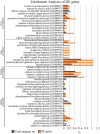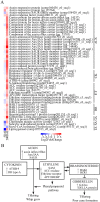RNAseq Transcriptional Profiling following Whip Development in Sugarcane Smut Disease
- PMID: 27583836
- PMCID: PMC5008620
- DOI: 10.1371/journal.pone.0162237
RNAseq Transcriptional Profiling following Whip Development in Sugarcane Smut Disease
Abstract
Sugarcane smut disease is caused by the biotrophic fungus Sporisorium scitamineum. The disease is characterized by the development of a whip-like structure from the primary meristems, where billions of teliospores are produced. Sugarcane smut also causes tillering and low sucrose and high fiber contents, reducing cane productivity. We investigated the biological events contributing to disease symptoms in a smut intermediate-resistant sugarcane genotype by examining the transcriptional profiles (RNAseq) shortly after inoculating the plants and immediately after whip emission. The overall picture of disease progression suggests that premature transcriptional reprogramming of the shoot meristem functions continues until the emergence of the whip. The guidance of this altered pattern is potentially primarily related to auxin mobilization in addition to the involvement of other hormonal imbalances. The consequences associated with whip emission are the modulation of typical meristematic functions toward reproductive organ differentiation, requiring strong changes in carbon partitioning and energy production. These changes include the overexpression of genes coding for invertases and trehalose-6P synthase, as well as other enzymes from key metabolic pathways, such as from lignin biosynthesis. This is the first report describing changes in the transcriptional profiles following whip development, providing a hypothetical model and candidate genes to further study sugarcane smut disease progression.
Conflict of interest statement
The authors declare that the research was conducted in the absence of any commercial or financial relationships that could be construed as a potential conflict of interest. Mendelics Análise Genômica provided support only in the form of a salary for author JPK. There are no patents, products in development or marketed products to declare. This does not alter the authors’ adherence to PLOS ONE policies on sharing data and materials.
Figures








References
-
- FAOSTAT, 2013. Food and Agriculture Organization Statistics Database. Available: http://faostat3.fao.org/faostat-geteway/go/to/home/E. Accessed 10 November 2015.
-
- Waclawovsky AJ, Sato PM, Lembke CG, Moore PH, Souza GM. Sugarcane for bioenergy production: an assessment of yield and regulation of sucrose content. Plant Biotechnol J.2010;8:3 Available: http://www.ncbi.nlm.nih.gov/pubmed/20388126. - PubMed
-
- Sundar AR, Barnabas EL, Matathi P, Viswanathan R. A Mini-Review on Smut Disease of Sugarcane Caused by Sporisorium scitamineum In: Mworia JK, editor. Botany. InTech; 2012. p. 107–28.
-
- Legaz ME, Armas R d., Pinon D, Vicente C. Relationships between phenolics-conjugated polyamines and sensitivity of sugarcane to smut (Ustilago scitaminea). J Exp Bot. 1998, 49:327 Available: http://jxb.oxfordjournals.org/cgi/content/long/49/327/1723.
-
- Bakkeren G, Kämper J, Schirawski J. Sex in smut fungi: Structure, function and evolution of mating-type complexes. Fungal Genet Biol.2008, 45 Available: http://www.sciencedirect.com/science/article/pii/S1087184508000650. - PubMed
MeSH terms
LinkOut - more resources
Full Text Sources
Other Literature Sources

